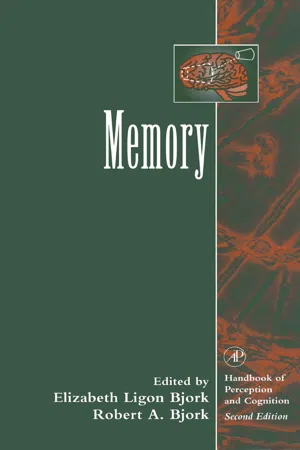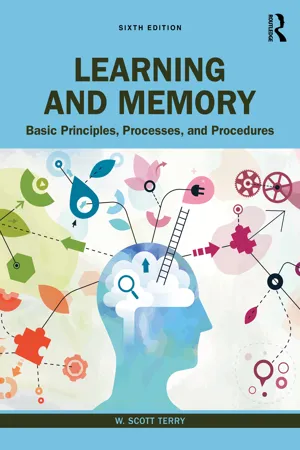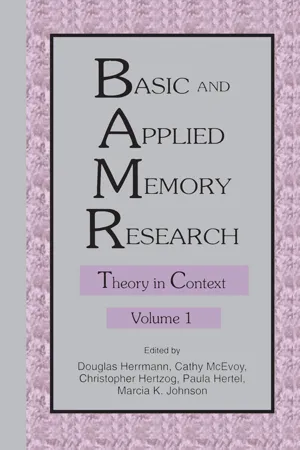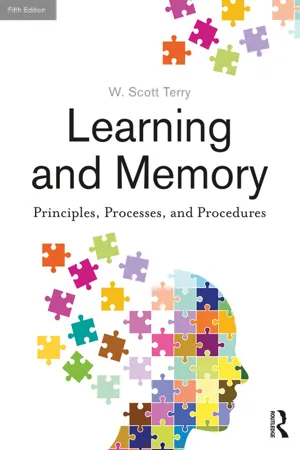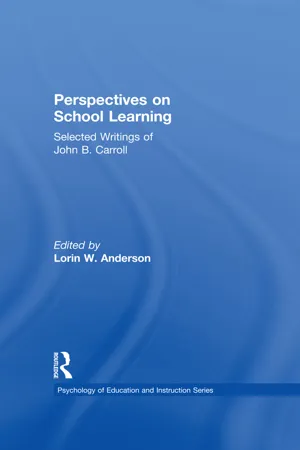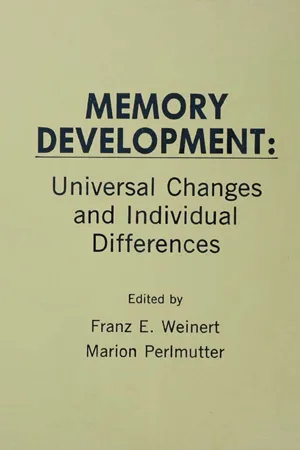Psychology
Individual Differences In Memory
Individual differences in memory refer to the variations in how people encode, store, and retrieve information. These differences can be influenced by factors such as genetics, age, and experience. Understanding individual differences in memory can help psychologists tailor interventions and strategies to improve memory function for individuals with different cognitive profiles.
Written by Perlego with AI-assistance
Related key terms
1 of 5
8 Key excerpts on "Individual Differences In Memory"
- eBook - PDF
- Elizabeth Ligon Bjork, Robert A. Bjork(Authors)
- 1996(Publication Date)
- Academic Press(Publisher)
If individuals who have more and better organized knowledge in long-term memory benefit from this difference, we must begin to ask how this difference arose in the first place. Doing so will help us not only in furthering our understanding of how people differ in their memory abilities, but also in deciphering the basic structure and processes of memory. Acknowledgments Because contributions were equivalent, order of authorship is alphabetical. Preparation of this chapter was supported by Grant A7459 from the Natural Sciences and Engineering Research Council of Canada to Colin M. MacLeod. Address correspondence to either author at Division of Life Sciences, University of Toronto, Scarborough Campus, Scarborough, Ontario M1C 1A4 CANADA (e-mail: bors or [email protected]). References Ackerman, P. L. (1986). Individual differences in information processing: An investigation of intellectual abilities and task performance during practice. Intelligence, 10, 101-139. Ackerman, P. L. (1987). Individual differences in skill learning: An integration of psychometric and information processing perspectives. Psychological Bulletin, 102, 3-27. Ackerman, P. L. (1988). Determinants of individual differences during skill acquisition: Cog- nitive abilities and information processing. Journal of Experimental Psychology: General, 117, 288-318. Ackerman, P. L. (1990). A correlational analysis of skill specificity: Learning, abilities, and individual differences. Journal of Experimental Psychology: Learning, Memory, and Cognition, 16, 883-901. Ackerman, P. L., Sternberg, R. J., & Glaser, R. (1989). Learning and individual differences. San Francisco: W. H. Freeman. Anderson, J. R. (1983). The architecture of cognition. Cambridge: Harvard University Press. Bachelder, B. L., & Denny, M. R. (1977). A theory of intelligence: II. The role of span in a variety of intellectual tasks. Intelligence, 1, 237-256. Baddeley, A. D. (1986). Working memory. - eBook - ePub
Learning and Memory
Basic Principles, Processes, and Procedures
- W. Scott Terry(Author)
- 2023(Publication Date)
- Routledge(Publisher)
Chapter 12 Individual Differences in Learning and MemoryDOI: 10.4324/9781003227090-12Contents
- The Nature of Nurture: The Genetics of Learning Ability
- Animal Studies
- Human Studies
- Age Differences in Learning and Memory
- Conditioning
- Memory Development in Children
- Aging and Memory
- Exceptional Memory: The Mnemonists
- Highly Superior Autobiographical Memory
- Gender and Cognitive Abilities
- Learning Styles
- The Visualizer–Verbalizer Dimension
- Kolb
- Sternberg
- Learning Styles?
- Self-Control
- Social and Cultural Differences
- Epic Memories
- Experimental Studies
- Contemporary Cultural Psychology
- Summary
One of the goals of a scientific psychology is to describe general laws. This textbook, which includes the word principles in its title, attempts to specify some general principles of learning and memory. There are exceptions to the principles, and individual differences are one source of variation. The combination of genes, physical constitution, environment, and life experiences causes each of us to react somewhat differently to what are seemingly similar situations. The remarkable thing, then, is that there are any general principles at all.It would be impossible to describe the laws for each and every individual. Instead, researchers focus on broad categories of differences. How are children and adults alike or different in their remembering? Are there personality or cultural differences that interact with the principles of learning?Two distinctive approaches to research in psychology are the experimental approach and the correlational approach (Cronbach, 1957 ). The experimental approach focuses on those variables that can be actively manipulated by researchers. The experimental approach looks for general principles that transcend individual differences. The correlational approach - eBook - ePub
Basic and Applied Memory Research
Volume 1: Theory in Context; Volume 2: Practical Applications
- Douglas J. Herrmann, Chris Hertzog, Cathy McEvoy, Paula Hertel, Marcia K. Johnson(Authors)
- 2013(Publication Date)
- Psychology Press(Publisher)
Chapter Eight What Are the Functional Bases of Individual Differences In Memory Ability? Patrick Rabbitt Qian Yang University of Manchester, Manchester, EnglandPeople differ markedly in memory ability, as in all other cognitive skills. Nevertheless, there are no satisfactory accounts of individual differences in the efficiency of functional processes underlying memory, possibly because cognitive psychologists have been more impressed by massive individual differences associated with extensive, domain specific practice (Ericcsen, Krampe, & Tesch-Rohmer, 1993) or invention and use of mnemonic techniques (Ericcsen & Chase, 1982; Ericcsen & Poison, 1988). Current models for how the efficiency of the functional processes underlying memory may vary between individuals polarize between identical hypotheses, remarkably without any cross-reference. One psychometric model proposes that all cognitive skills, including memory, load on a single factor of general intellectual ability such as Spearman’s (1927) “g” (for a recent discussion, see Gustafson, 1984). Interest in this somewhat dated view has been revived by the suggestion that “g” can be reified in terms of some particular performance parameter of the functional cognitive system. One suggestion has been information processing speed (Anderson, 1992; Bates & Eysenck, 1993; Brand & Deary, 1982; Eysenck, 1986; Hulme & Turnbull, 1983; Jensen, 1980; Nettelbeck, 1982; Smith & Stanley, 1983; Vernon, 1983, 1985; Vernon & Jensen, 1984). A more recent is “working memory capacity” (Carpenter, Just, & Shell, 1990; Kyllonen & Crystal, 1990). The evidence is modest, but ubiquitous correlations between performance on pencil-and-paper “intelligence tests” (IQ Test Scores, IQTS) and performance indices derived from simple laboratory tasks such as Choice Reaction Time (CRT) or tachistoscopic recognition thresholds (“Inspection Times,” ITs) and supposedly more direct indices of Central Nervous System (CNS) efficiency such as latencies of early, p100 - eBook - ePub
Learning and Memory
Basic Principles, Processes, and Procedures, Fifth Edition
- W. Scott Terry(Author)
- 2017(Publication Date)
- Routledge(Publisher)
Individual Differences in Learning and MemoryThe Nature of Nurture: The Genetics of Learning Ability Animal Studies Human Studies Age Differences in Learning and Memory Conditioning Memory Development in Children Aging and Memory Intellectual Deficits Conditioning Memory Learning Disabilities Exceptional Memory: The Mnemonists Gender and Cognitive Abilities Personality and Learning Self-Control Anxiety Learning Styles The Visualizer–Verbalizer Dimension Kolb Sternberg Learning Styles? Social and Cultural Differences Epic Memories Experimental Studies SummaryO ne of the goals of a scientific psychology is to describe general laws. This textbook, which includes the word principles in its title, attempts to specify some general, maybe even universal, principles of learning and memory. There are exceptions to the principles, and individual differences are one source of variation. The combination of genes, physical constitution, environment, and life experiences causes each of us to react somewhat differently to what are seemingly the same situations. The remarkable thing, then, is that there are any general principles at all!It would be impossible to describe the laws for each and every individual. Instead, researchers focus on broad categories of differences. How are children and adults alike or different in their remembering? Are there gender or personality differences that interact with the principles of learning?Two distinctive approaches to research in psychology are the experimental approach and the correlational approach (Cronbach, 1957). The experimental approach focuses on those variables that can be actively manipulated by researchers, in order to demonstrate what effects these variables have on learning. The experimental approach seeks the general principles that transcend individual differences. The correlational approach - eBook - ePub
- Timothy J Perfect, D Stephen Lindsay, Timothy J Perfect, D Stephen Lindsay, Author(Authors)
- 2013(Publication Date)
- SAGE Publications Ltd(Publisher)
Moonwalking with Einstein, also strongly makes the case for practice in the context of memory improvement techniques.In this chapter, we address 12 questions about how and why people’s memory abilities differ. We chose these 12 because, in our experience, they are the most frequently asked questions in university and public lectures on memory. We will argue overall that the two major factors underlying Individual Differences In Memory are the operation of working memory and the knowledge stored in long-term memory, with additional contributions from motivation and personality. Our primary goals will be to show where the differences in memory ability are worthy of note, what might bring about the differences, and how what we know about these differences enhances our understanding of memory. Psychologists periodically call for better integration of individual differences research into our general theorizing (e.g., Cronbach, 1957): This need is at least as great in the domain of memory as elsewhere (see, e.g., Melton, 1967; Underwood, 1975). Surely the range of memory abilities constitutes a major element of memory that must be explained.Table 22.1 shows the twelve questions about Individual Differences In Memory that we will try to answer – or at least to summarize what we know. But before we begin answering these central questions, how can we measure memory in the first place?MEASURING MEMORYThe best known psychometric test designed to measure different memory functions is the Wechsler Memory Scale. Originally developed in 1945 and now in its fourth edition (WMS-IV; 2009), it consists of seven subtests: brief cognitive status exam, spatial addition, symbol span, design memory, logical memory, verbal paired associates, and visual reproduction. These are then combined and reported as five Index Scores: Auditory Memory, Visual Memory, Visual Working Memory, Immediate Memory, and Delayed Memory. When factor-analyzed to determine the underlying traits, the two dominant factors are a general memory factor and an attention/concentration factor (Roid, Prifitera, & Ledbetter, 1988). WMS-IV was designed to accompany the Wechsler Adult Intelligence Scale, fourth edition (WAIS-IV; 2008), which also contains a working memory index made up of two subtests – digit span and arithmetic. The major use of the WMS is as a neuropsychological tool to evaluate people with suspected memory problems, but it can also be used to measure normal memory. - eBook - PDF
- Beverly Irby, Genevieve H. Brown, Rafael Lara-Aiecio(Authors)
- 2015(Publication Date)
- Information Age Publishing(Publisher)
767 The Handbook of Educational Theories , pp. 767–782 Copyright © 2013 Information Age Publishing, Inc. All rights of reproduction in any form reserved. CHAPTER 64 Individual Differences in the Ability to Process Information W. J. SCHNEIDER and K. S. M C GREW W. Joel Schneider Illinois State University Kevin S. McGrew The Institute of Applied Psychometrics Cognitive performance models attempt to integrate the findings of two grand traditions of scientific psychol-ogy: the experimental study of information processing and the measurement of individual differences in cog-nitive abilities. One tradition is concerned with how the mind typically works while the other describes how minds differ. To use a statistical metaphor and only a mild exaggeration, one is about the mean, the other the standard deviation. One tradition draws mostly from experimental findings from academic labs whereas the other draws primarily from population-wide psycho-metric studies of cognitive abilities thought to be important for success in academic, occupational, and other life settings. Information processing theories describe the inter-play of perception, attention, memory, and reasoning as people learn information and solve problems. Although information processing theorists do care about the brain, their emphasis is less on brain function location and more how the brain processes information during the learning and problem-solving process. Information processing theorists acknowledge the fact that not all people process information equally well or even in the same way. However, the emphasis is less on understanding the unique challenges of individuals and more on understanding what we have in common, the species-typical functions of the mind. In contrast, cognitive ability theorists focus on iden-tifying meaningful differences in people’s measured discrete abilities. - eBook - ePub
Perspectives on School Learning
Selected Writings of John B. Carroll
- L. W. Anderson(Author)
- 2014(Publication Date)
- Routledge(Publisher)
1. Simple judgments of stimulus attributes such as to reveal identity, similarity, or differences between two stimuli. 2. Certain manipulations of STM contents, such as “imaging” or otherwise abstractly representing an item, imaging a figure-in-ground, and mentally rotating a visuospatial configuration.3. “Serial” operations using algorithms from the general logic store (or, more generally, a production system that includes such algorithms). That is, certain elements are operated on, producing new elements. These in turn are operated on, producing still further elements, and so on until the process is terminated (either successfully or unsuccessfully). Individual differences concern the ability to perform these operations efficiently and correctly with whatever algorithm or algorithms are being used. (Of course, individual differences also arise from whether appropriate algorithms are in fact being used, but such differences are assigned to differences in contents of relevant LTM memory stores.)Response Aspects of the FactorsA final column of the table notes whether individual differences may be presumed in the temporal parameters of “response rendering.” This applies to the particular tests offered in the French et al. Kit of Reference Tests for Cognitive Factors. Many of these tests (usually, all tests of a given factor) require the subject to render his or her response by writing words, phrases, or sentences, rather than simply selecting a response. We know that there are individual differences in writing speed (Carroll, 1941) that enter into test correlations. The table notes factors in which such individual differences may play a role, although it may not be that such a role is essential to their measurement.Characterizations of the Factors in Terms of Cognitive ProcessesIn the following “characterizations,” I must emphasize again that the descriptions address only aspects of tasks that involve individual differences. The factors are arranged roughly in terms of the type of memory and the number of cognitive processes that are involved. (This is also the order in which the factors are presented in Table 2 - eBook - ePub
Memory Development
Universal Changes and Individual Differences
- Franz E. Weinert, Marion Perlmutter, Franz E. Weinert, Marion Perlmutter(Authors)
- 2013(Publication Date)
- Psychology Press(Publisher)
Thus, study of the structures, processes, and functioning of the memory system continues to be a fundamental endeavor of cognitive psychology in the expectation that the findings will advance theoretical ideas and produce practical benefits. The study of memory development plays a significant role in this endeavor. Systematic observation of the ways in which changes in cognitive resources across the life span affect different types of memory performance is likely to encompass a greater range of phenomena than can be obtained in laboratory investigations with adult subjects. In addition, cross-cultural comparisons and training studies allow the investigation of the plasticity of human memory systems. Such studies have the particular value of providing a basis on which instructional treatments and teaching demands can be adjusted to the developmental levels achieved by the learners.Considering the volume of theoretical and experimental work in memory development during the past decades, it is at first glance surprising that the results of current research receive such disparate evaluations in the different chapters of this volume. Whereas some of the contributors note that significant progress has been made in our understanding of memory development (e.g., Borkowski et al., Pressley et al.), others tend to be more skeptical and critical. Thus Perlmutter (this volume) emphasizes that “present understanding of memory is limited by the restrictive focus on only a very special kind of memory, that is on deliberate memory of symbolic information over short time intervals in extremely sterile situations.” Similar deficits are noted by Paris, Ceci et al., Verdonik, and Dixon and Hertzog. In general, although these critiques do not deny that progress has been made within a number of research paradigms, they point to the narrow scope of current definitions of memory development and current methodological approaches. It is worthwhile to examine the progress and shortcomings a little more closely. To this end, I first discuss the highlights of current research on memory development, then attempt to clarify what memory research in developmental psychology really studies, and finally, draw some conclusions concerning the directions that future research should take.
Index pages curate the most relevant extracts from our library of academic textbooks. They’ve been created using an in-house natural language model (NLM), each adding context and meaning to key research topics.
